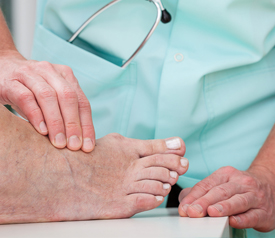
What is a bunion?
Most people think a bunion is a bump on the side of the foot. In some respects, this is true; however, thinking of a bunion as just a bump minimizes the true nature of this serious orthopedic condition. A bunion is actually bone (and some soft tissue) jutting out from the side of the foot, at the joint where the big toe connects with the rest of the foot. The big toe is abnormally bent toward the other toes, which leaves the large bone of the foot (metatarsal) relatively unprotected. It is this bone that forms the bunion “bump.” In some cases bunion surgery may be needed.
Bunion symptoms
The main symptom of a bunion is foot pain. The joint between the toe and the rest of the foot (first metatarsophalangeal joint) becomes inflamed, swollen, and tender. The abnormality can also cause bursitis, tendonitis, nerve entrapment, synovitis, and cartilage damage. Foot and toe pain are often worse when wearing tight shoes, but large bunions can hurt even when one wears wide shoes. In some patients, bunions do not cause pain, but the bump and the angle of the toe are clearly abnormal.
What causes a bunion?
Some sources suggest tight-fitting shoes cause bunions. While this theory may make sense, there is little scientific evidence to support it. Most women wear very-tight-fitting shoes and never develop bunions, while men who wear wide shoes with ample toe boxes can develop severe disease. More likely, bunions are caused by a combination of genetics, underlying joint deformities, existing anatomical abnormalities, and joint hypermobility—all of these made worse by tight-fitting shoes.
Medical treatments for bunions
Bunions only need treatment if they cause symptoms. Most doctors—even orthopedic surgeons—will offer non-surgical, conservative treatments for symptomatic bunions first. Perhaps the easiest non-surgical treatment for bunions is to simply wear flat shoes with ample room for the toes. This doesn’t change the look of the bunion or cure it, but some people who make the switch in footwear experience pain relief. Other conservative treatments for bunions include orthotics, splints, and physical therapy. Orthotics (orthoses) are inserts that are worm in the bottoms of your shoes. Orthotics help spread or separate the toes. Splints are a bit more involved than orthoses in that they hold the toes and foot in a particular orientation. Neither orthotics nor splint correct the deformity, but they may relieve pain. The same is true for physical therapy.
Do I need bunion surgery?
Unfortunately, non-surgical treatments for bunions are not always effective. Most patients with moderate or severe disease will ultimately need bunion surgery. If your bunion causes substantial pain or it keeps you from walking like you used to and conservative bunion treatments have failed to provide relief, then bunion surgery is probably needed.
What happens during bunion surgery?
There are many ways to perform bunion surgery (about 150), from shaving off a bit of bone (bunionectomy) to fusing the metatarsophalangeal joint (permanently uniting the big toe to foot bone), to joint replacement (arthroplasty). Your orthopedic surgeon or podiatrist can discuss your bunion surgery options. You will also have the option of local/regional, spinal (epidural) and general anesthesia. Regardless of the type of surgery or anesthesia you choose, bunion surgery recovery is a long and involved process.
What can I expect after bunion surgery?
Bunion surgery is an outpatient procedure, which means you can go home the same day of the surgery. However, this is only the start of the recovery process. Bunion surgery recovery takes about six to eight weeks—six weeks to return to work and eight weeks to return to playing sports. Indeed, it takes about six weeks for the bone to heal. However, the healing process continues after recovery and may take six months or more. In fact, bunion symptoms may continue to improve between 6 months and 12 months after surgery.
After bunion surgery, you will be required to wear a surgical boot (or plaster cast) for two weeks. The boot is usually removed at the same time as the stitches (sutures). You will likely need to keep your foot elevated for most of that time.
Importantly, you will likely not be able to put any weight on the affected foot during the first two weeks after surgery. In fact, you may still not be able to walk on the foot for several days after the boot/cast is removed. Patients generally need a lot of help during this time to get around and to care for themselves. You will need crutches and perhaps a wheelchair or knee scooter during the initial recovery period. Your orthopedic surgeon/podiatrist and physical therapist can develop a program for returning to activity and a set of exercises to condition the muscles in the treated area.
As you would expect, tight-fitting shoes are not recommended. Instead, patients should wear flat shoes (or low arches) that provide support but are not too narrow. Athletic shoes (walking shoes or skateboarding shoes) are usually a good choice.
Bunion surgery wound care
It is essential to keep the surgical wound dry and clean after bunion surgery. The dressing will need to be changed frequently, and even more often if it becomes damp with fluid or blood or becomes soiled. You will be able to bathe, but the area should be kept completely covered with a plastic bag. Some people find sponge baths to be easier than regular baths or showers.
Because dressings and proper wound care are critical for recovery after bunion surgery, the medical tape you choose matters. Hy-Tape is extremely well-suited to this application. It has several properties that make it particularly useful for post bunion surgery wound care.
Hy-Tape is waterproof—when combined with the correct dressing, Hy-Tape can keep the surgical wound dry, which is critical for proper healing. Even though Hy-Tape is thin, it holds fast. Bunion surgery creates a surgical wound in an odd place—not all tape can reach, hold, and remain waterproof on the edge of the foot and in between toes. It is Hy-Tape’s thinness and pliability that allows it to conform to the odd curvatures of the foot. While it may not seem like a big issue, Hy-Tape has a gloss coating, which makes it easier to put on and take off socks. It is the little things like this that can make the long recovery from bunion surgery a bit easier.
If you are contemplating bunion surgery, Hy-Tape wants to help make your recovery easier and successful. Contact us for a free sample of Hy-Tape to use during bunion surgery recovery. We think you’ll be pleased with the results.
- Vanore JV, Christensen JC, Kravitz SR, et al. Diagnosis and treatment of first metatarsophalangeal joint disorders. Section 1: Hallux valgus. J Foot Ankle Surg. 2003 May-Jun;42(3):112-23.
- Kristen KH, Berger C, Stelzig S, et al. The SCARF osteotomy for the correction of hallux valgus deformities. Foot Ankle Int. 2002 Mar;23(3):221-9.
- Blitz NM1, Lee T, Williams K, et al. Early weight bearing after modified lapidus arthodesis: a multicenter review of 80 cases. J Foot Ankle Surg. 2010 Jul-Aug;49(4):357-62. doi: 10.1053/j.jfas.2010.04.014.
- Dux K, Smith N, Rottier FJ. Outcome after metatarsal osteotomy for hallux valgus: a study of postoperative foot function using revised foot function index short form. J Foot Ankle Surg. 2013 Jul-Aug;52(4):422-5. doi: 10.1053/j.jfas.2013.03.004. Epub 2013 May 4.
Related Topics:

